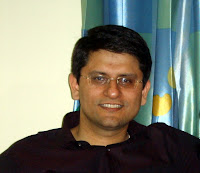Saturday, June 30, 2007
Candidate for the EDA
For a long time, I am reading excellent posts on SOA and EDA blog by Jack Van Hoof. EDA reminds me of Telecom domain. This domain is excellent candidate for EDA. Telecom network generates the events. These events are intercepted by application services like Prepaid, Ringback tone, Follow me, VPN etc.
Explaining my point with scenario like execution of Single Service -
Consider scenario where prepaid caller dials a called party number. A event is generated, service capture the calling party number and called party number. Based on called party number it routes the call. Now caller listens the ringing. Called party picks up the phone. Another event is generated. Service captures the events and starts charging. There is voice channel between caller and called party. After sometime, called party hangs the phone call. Another event is generated and service based on this event stops charging and persist the duration of call. In this flow, based on current event and last event result, application service executes the business logic. There is requirement for storing the state of call. This makes scenario little bit complex. Events cann't be consider stateless in real sense.
Execution of Multiple Services
In this case, one approach is to introduce Service Manager and this Service Manager further manages the interactions with several services and their sequencing.
In contrast with Enterprise application, Telecom applications are more chatty i.e. Events are too many and are of very short duration. Due to this, scalability and performance becomes burning issues. Secondly, all these events are in real time. While events are processed, customers are waiting for call to connect, waiting for ring back tone, announcements etc. It makes true testing ground for EDA.
In last, I feel, SOA and EDA could change the landscape of Telecom services. Niche companies could provide services like charging, rating, application services on internet. These services could be consumed by operators instead every one building themselves. Telecom domain is always a front runner at concept level. Hub & Spoke model of Telecom switches was innovated three decades back. This model is foundation for buzzword ESB nowadays.
Explaining my point with scenario like execution of Single Service -
Consider scenario where prepaid caller dials a called party number. A event is generated, service capture the calling party number and called party number. Based on called party number it routes the call. Now caller listens the ringing. Called party picks up the phone. Another event is generated. Service captures the events and starts charging. There is voice channel between caller and called party. After sometime, called party hangs the phone call. Another event is generated and service based on this event stops charging and persist the duration of call. In this flow, based on current event and last event result, application service executes the business logic. There is requirement for storing the state of call. This makes scenario little bit complex. Events cann't be consider stateless in real sense.
Execution of Multiple Services
In this case, one approach is to introduce Service Manager and this Service Manager further manages the interactions with several services and their sequencing.
In contrast with Enterprise application, Telecom applications are more chatty i.e. Events are too many and are of very short duration. Due to this, scalability and performance becomes burning issues. Secondly, all these events are in real time. While events are processed, customers are waiting for call to connect, waiting for ring back tone, announcements etc. It makes true testing ground for EDA.
In last, I feel, SOA and EDA could change the landscape of Telecom services. Niche companies could provide services like charging, rating, application services on internet. These services could be consumed by operators instead every one building themselves. Telecom domain is always a front runner at concept level. Hub & Spoke model of Telecom switches was innovated three decades back. This model is foundation for buzzword ESB nowadays.
Friday, June 29, 2007
Integrity of Bloggers
Few months back, there was lot of buzz around the Blogger's Code of Conduct from O'Reilly Radar. My viewpoint is that blog shows the level of Blogger integrity. My thoughts about Employers and Employees perspectives are -
Employers Perspective - Many companies are not in favour of employees expressing views in public domain. If you see from employers viewpoints, not all employees are mature and have high level of integrity. There are intermittent periods when employee is not satisfied due to any reason and publish their views based on perception or prejudice not on facts. Blogging requires high degree of mutual trust between employers and employees.
Employee Perspective - A blogging demands a high integrity from the bloggers. In my view, best practice is to keep blog independent of company references. Never ever share the company information or link to company site. Blog's objective is to share your thoughts with people with same frequency. There is no inherent requirement to share any kind of company information.
Few attributes of good bloggers -
1. Ownership - Any comments published on one's blog are responsibility of blogger. Always keep moderation on for your blog. Just publishing a disclaimer is not enough.
2. True Character -Its a test of one character when things are not moving in right direction in professional life, one should resist any comments on it. This is time when you will do something unethical. If you can't resist and can't stop yourself from mud slugging, stop blogging for sometime.
3. Correct information - Bloggers shall share the correct information. It should not be biased based on one's goals. This shared information is for the benefit of bloggers community. This is platform which provides the opportunity to learn from each other experiences. May be good idea is to declare one's level of expertise on blog topic.
4. Respect - Show respect for other bloggers. Only constructive comments drives the fruitful discussion.
Happy Blogging !!
Employers Perspective - Many companies are not in favour of employees expressing views in public domain. If you see from employers viewpoints, not all employees are mature and have high level of integrity. There are intermittent periods when employee is not satisfied due to any reason and publish their views based on perception or prejudice not on facts. Blogging requires high degree of mutual trust between employers and employees.
Employee Perspective - A blogging demands a high integrity from the bloggers. In my view, best practice is to keep blog independent of company references. Never ever share the company information or link to company site. Blog's objective is to share your thoughts with people with same frequency. There is no inherent requirement to share any kind of company information.
Few attributes of good bloggers -
1. Ownership - Any comments published on one's blog are responsibility of blogger. Always keep moderation on for your blog. Just publishing a disclaimer is not enough.
2. True Character -Its a test of one character when things are not moving in right direction in professional life, one should resist any comments on it. This is time when you will do something unethical. If you can't resist and can't stop yourself from mud slugging, stop blogging for sometime.
3. Correct information - Bloggers shall share the correct information. It should not be biased based on one's goals. This shared information is for the benefit of bloggers community. This is platform which provides the opportunity to learn from each other experiences. May be good idea is to declare one's level of expertise on blog topic.
4. Respect - Show respect for other bloggers. Only constructive comments drives the fruitful discussion.
Happy Blogging !!
Saturday, June 23, 2007
SOAtization of Enterprise Culture
For last few years, whenever any projects is initiated or any product is launched, it claims to be following principles of SOA. Most of big Enterprise claims that they are in process of successfully adopting SOA. To measure the maturity, one can find many SOA maturity models on lines of CMMi models.
Actually, SOAtization of Enterprise is a change in culture of Enterprise. One needs lots of impact players, support of management, proper communication to developer community, strong collaboration with business and Enterprise Architecture team.
SOA is a concept, architecture approach and above all its a cultural change. Enterprise starts discussing in taxonomy of business processes. Top down approach is followed to find business services. Delivery teams believes in building reusable business services and infrastructure services. A proper governance exists and services are registered in repository. People don't owns the applications and projects.
Simple way to check the SOAtization of the Enterprise is to find whether people are building business processes or applications.
Actually, SOAtization of Enterprise is a change in culture of Enterprise. One needs lots of impact players, support of management, proper communication to developer community, strong collaboration with business and Enterprise Architecture team.
SOA is a concept, architecture approach and above all its a cultural change. Enterprise starts discussing in taxonomy of business processes. Top down approach is followed to find business services. Delivery teams believes in building reusable business services and infrastructure services. A proper governance exists and services are registered in repository. People don't owns the applications and projects.
Simple way to check the SOAtization of the Enterprise is to find whether people are building business processes or applications.
Tuesday, June 19, 2007
SOA - The Elephant

There is always a debate who should drive the SOA initiative in Enterprise. It could be business, architecture team, delivery or Operations team. It benefits all of them in different ways. SOA from different viewpoints looks like
- Business see SOA as a set of business services that are exposed to its clients. It reduces the time to market and costs of building business processes. It increases business agility and simplify the IT.
- Architects see SOA as an architectural approach to build business processes. It is based on well known principles and patterns like loose coupling, separation of concerns, encapsulation etc. It constitutes of provider, consumer and contract.
-Developer see SOA as a set of standards, tools and technologies like Web Services.
-Operational people see SOA as a better contract between Service provider and Service consumer.
In my view, SOA impacts the entire Enterprise and everyone is stakeholder. Unlike earlier concepts of distributed computing in IT, SOA is more near to business people. Hope IT will fulfill the agility and reusability promise this time.
Monday, June 04, 2007
Subscribe to:
Comments (Atom)
"That man is successful who has lived well, laughed often, and loved much; who has gained the respect of the intelligent men and the love of children; who has filled his niche and accomplished his task; who leaves the world better than he found it, whether by an improved poppy, a perfect poem, or a rescued soul; who never lacked appreciation of earth's beauty or failed to express it; who looked for the best in others and gave the best he had." - Ralph Waldo Emerson


